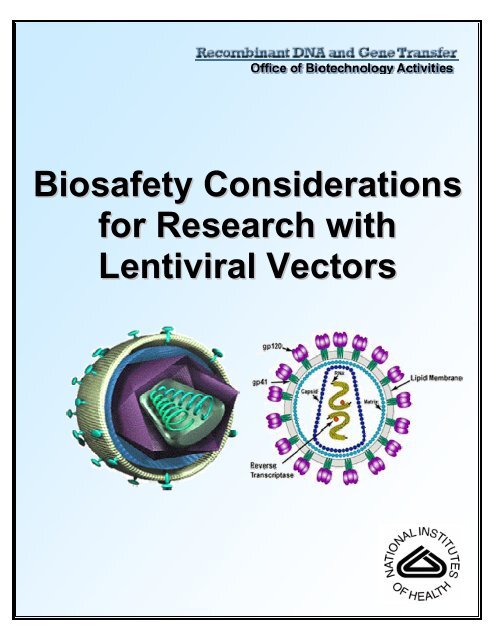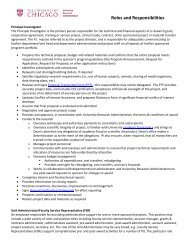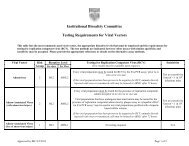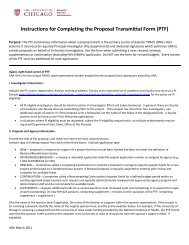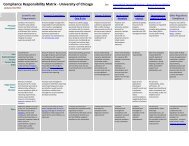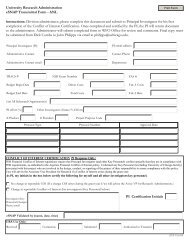Biosafety Considerations for Research with Lentiviral Vectors
Biosafety Considerations for Research with Lentiviral Vectors
Biosafety Considerations for Research with Lentiviral Vectors
You also want an ePaper? Increase the reach of your titles
YUMPU automatically turns print PDFs into web optimized ePapers that Google loves.
<strong>Biosafety</strong> <strong>Considerations</strong><strong>for</strong> <strong>Research</strong> <strong>with</strong><strong>Lentiviral</strong> <strong>Vectors</strong>
<strong>Biosafety</strong> <strong>Considerations</strong> <strong>for</strong> <strong>Research</strong> <strong>with</strong> <strong>Lentiviral</strong><strong>Vectors</strong>Recombinant DNA Advisory Committee (RAC) Guidance DocumentBackground: The use of lentiviral vectors has been increasing because the vectorsystem has attractive features; however, such research also raises biosafety issues. TheNIH Office of Biotechnology Activities has received frequent questions regarding theappropriate containment <strong>for</strong> lentiviral vectors, particularly those derived from HIV-1.Because the NIH Guidelines <strong>for</strong> <strong>Research</strong> Involving Recombinant DNA Molecules (NIHGuidelines) do not explicitly address containment <strong>for</strong> research <strong>with</strong> lentiviral vectors, theRAC was asked to provide additional guidance <strong>for</strong> institutional biosafety committees(IBCs) and investigators on how to conduct a risk assessment <strong>for</strong> lentiviral vectorresearch. At the March RAC 2006 meeting, the RAC offered the following findings andrecommendations.Risks of lentivirus vectors: The major risks to be considered <strong>for</strong> research <strong>with</strong> HIV-1based lentivirus vectors are:• Potential <strong>for</strong> generation of replication-competent lentivirus (RCL), and• Potential <strong>for</strong> oncogenesis.These risks can be mitigated by the nature of the vector system (and its safety features)or exacerbated by the nature of the transgene insert encoded by the vector.General criteria <strong>for</strong> risk assessment of lentivirus vectors: Decisions aboutcontainment should take into account a range of parameters/considerations including:• The nature of the vector system and the potential <strong>for</strong> regeneration ofreplication competent virus from the vector components,• The nature of the transgene insert (e.g., known oncogenes or genes <strong>with</strong> highoncogenic potential may merit special care)• The vector titer and the total amount of vector,• The inherent biological containment of the animal host, if relevant,• Negative RCL testing (see section below)General containment considerations: Either BL2 containment or enhanced BL2containment is often appropriate in the laboratory setting <strong>for</strong> research involving the useof advanced lentivirus vector systems that have multiple safety features and thatsegregate vector and packaging functions onto four or more plasmids. Enhanced BL2containment may include in addition to attention to sharps (and use of safety needleswhere feasible), the use of personal protective equipment intended to reduce thepotential <strong>for</strong> mucosal exposure to the vector. In most such research, these levels ofcontainment are also expected to be appropriate even when producing large volumes ofHIV-1 vectors (>10 L).The appropriate containment level <strong>for</strong> specific lentivirus vector research is, of course,determined following a complete risk assessment and local IBC review. The followingsections discuss some considerations which should <strong>for</strong>m an important part of thebiosafety assessment <strong>for</strong> research involving lentivirus vectors.
Potential <strong>for</strong> generation of replication competent lentivirus (RCL) from HIV-1 based lentivirus vectors: The potential <strong>for</strong> generation of RCL from HIV-1 basedlentivirus vectors depends upon several parameters, the most important of which are:• The number of recombination events necessary to reassemble a replicationcompetent virus genome, and• The number of essential genes that have been deleted from thevector/packaging system.On this basis, later generation lentivirus vector systems are likely to provide <strong>for</strong> a greatermargin of personal and public safety than earlier vectors, because:• They use a heterologous coat protein (e.g., VSV-G) in place of the nativeHIV-1 envelope protein (However, the use of the certain coat proteins, suchas VSV-G, may broaden the host cell and tissue tropism of lentivirus vectors,which should also be considered in the overall safety assessment by theIBC),• They separate vector and packaging functions onto four or more plasmids,and• They include additional safety features (e.g., they do not encode Tat, which isessential <strong>for</strong> replication of wild-type HIV-1).In contrast, earlier vector systems (such as two-plasmid vector systems) may have ahigher potential <strong>for</strong> generation of RCL.RCL testing: The National Gene Vector Laboratory (NGVL) has produced over 60liters of HIV-1 vector and has screened supernatant and cells from different vectorsystems, using different assays, <strong>with</strong>out detecting RCL (K. Cornetta, personalcommunication of unpublished data). This suggests that the frequency of RCLgeneration using lentivirus vectors is very low. It may not, however, be zero. There is aneed <strong>for</strong> continued investigation of RCL generation using lentivirus vectors, in order toin<strong>for</strong>m and advance the field of lentivirus vector technology.The FDA requires that lentiviral vector stocks used in human clinical trials be tested <strong>for</strong>RCL. Individual research laboratories conducting preclinical research often use onlysmall volumes (e.g., a few milliters) of lentivirus vectors expressing lower risk transgenessuch as GFP. While these laboratories are not mandated to characterize vector stocks,such testing should be encouraged. However, RCL testing requires expertise <strong>with</strong> theappropriate assays and such expertise may not be available in laboratories that do notwork regularly <strong>with</strong> infectious lentiviruses. In such laboratories, the use of a positivecontrol may increase risk to the investigator as compared to use of the test material.IBCs may make containment assignments <strong>with</strong>out requiring such testing by undertakinga risk assessment that considers the nature of the specific vector system being used andoverall past experience <strong>with</strong> the system.Animal studies: Some animals, such as wild-type mice, cannot support replication ofinfectious HIV-1. As a result, the potential <strong>for</strong> shedding of RCL from such animals is verylow (even if RCL were present in the original vector inoculum). IBCs may consider thebiosafety issues associated <strong>with</strong> animal husbandry and housing after the initial injectionseparately from the initial inoculation itself. In general, the initial delivery of vector should
e per<strong>for</strong>med under BL2 or BL2-N, according to the animal model, or under enhancedBL-2/BL2-N containment (see "General containment considerations"), so as to minimizethe risk of autoinoculation by the investigator. However, it may be permissible to reducethe containment level at some point following vector delivery. For example, if there is noexpectation of infection (see below), the site of inoculation has been thoroughlycleansed, and the bedding changed, it may be acceptable to consider reducingcontainment from BL2/BL2-N to BL1/BL1-N <strong>with</strong>in a few days (the specific time periodcan be specified by the local IBC, and may vary anywhere from 1-7 days depending onlocal and experimental considerations). Animals engrafted <strong>with</strong> human cells or animalhosts that are permissive <strong>for</strong> HIV-1 replication constitute a special case, in light of theirpotential to support replication of infectious HIV-1. Use of lentivirus vectors in theseanimals requires a higher level of containment.Other lentivirus vectors: Some non-human lentivirus vectors (e.g., FIV, SIV, EIAV,etc.) are also in use. Of these, the most frequently encountered are felineimmunodeficiency virus (FIV) vectors. In the Appendix B-V of the NIH Guidelines, acontainment level appropriate <strong>for</strong> Risk Group 1 agents is recommended <strong>for</strong> use ofcertain animal viral etiologic agents not associated <strong>with</strong> disease in healthy human adults.However, replication-defective vectors in which a heterologous envelope (such as VSV-G) is used <strong>for</strong> vector packaging may require BL2 containment in the laboratory setting,since these vectors have the potential to transduce human cells, and thus have thepotential to cause insertional mutagenesis. Under circumstances in which mice are notpermissive hosts <strong>for</strong> FIV replication, BL1 containment may be acceptable <strong>for</strong> mousehousing and husbandry when dealing <strong>with</strong> mice that have received FIV vectors (subjectto the considerations noted above).Summary: A comprehensive risk assessment and determination of containment <strong>for</strong>research <strong>with</strong> lentiviral vectors should consider the nature of the vector system,transgene insert, and type of manipulations involved. For many experiments, either BL-2or enhanced BL-2 will be appropriate. Examples of biosafety considerations and riskassessments <strong>for</strong> three different scenarios are included below.
Examples of <strong>Biosafety</strong> <strong>Considerations</strong>Vector <strong>Considerations</strong>:• Potential <strong>for</strong> generation of RCLo Vector and packaging functions separated onto multiple plasmidso Deletion of viral genes• Viral Env used in packaging systemo Non-native Env (decrease potential <strong>for</strong> generation of RCL)o Coat protein that increases species or cell type tropism of parentvirus (e.g., VSV-G)• Safety modifications (e.g., no expression of Tat)Transgene <strong>Considerations</strong>:• Oncogene• Non-oncogeneVector Generation <strong>Considerations</strong>:• Laboratory scale• Large scaleAnimal <strong>Research</strong> <strong>Considerations</strong>:• Permissive host• Non-permissive host• Animal engrafted <strong>with</strong> permissive cells• Vector Administration (e.g., injection)• Housing and husbandryPractices, Containment Equipment and Training <strong>Considerations</strong>:• Training in use of PPE• Availability of safety equipment (e.g., sealed centrifuge rotor cups)• Laboratory-specific safety and spill cleanup protocols• Availability of on-site occupational health support in the event of accident
<strong>Biosafety</strong> <strong>Considerations</strong> and Risk Levels<strong>Biosafety</strong><strong>Considerations</strong>Higher RiskLower RiskVector Design • Vector packaging functionson two plasmids• Expression of viral genes• Vector and packagingfunctions separated ontomultiple plasmids• Deletion of viral genesTransgene • Oncogene • Non-oncogeneVectorGeneration• Large scale • Laboratory scaleAnimal Hosts • Permissive host• Animals engrafted <strong>with</strong>human cells• Non-permissive hostAnimalManipulation• Vector administration (e.g.,use of sharps duringinjection• Housing and husbandry (nouse of sharps)
EXAMPLE SCENARIOSEXAMPLE ONE: In vitro study A: Use of a 4-plasmid derived lentivirusvector encoding siRNA against Lck in primary human T cells.<strong>Considerations</strong>1. What is the amount of vector to be produced? A = LOW (100 ml)2. What is the nature of the vector? A = 4-Plasmid System3. What is the nature of the insert? A = Non-OncogenicTentative Safety Assessment = BL2(Note that the use of primary human cells would require BL2 containment,independent of the vector, as well as use of Universal Precautions andcompliance <strong>with</strong> the OSHA standard <strong>for</strong> Bloodborne Pathogens -- 29 CFR1910.1030)EXAMPLE TWO: In vitro study B: Use of a 2-plasmid derived lentivirusvector encoding luciferase in a human cell line (A549 cells).<strong>Considerations</strong>1. What is the amount of vector to be produced? A = LOW (100 ml)2. What is the nature of the vector? A = 2-Plasmid System (non-commercial)3. What is the nature of the insert? A = Non-OncogenicTentative Safety Assessment = BL2 enhancedBL2 "enhanced" stipulations might include:• Avoidance of needles and sharps, where possible• Use of a containment hood <strong>for</strong> all work <strong>with</strong> the vector (including theloading and unloading of centrifuge rotors, which should have an aerosoltightseal)• Use of personal protective equipment [PPE] designed to prevent amucosal exposure/splash to the face and exposure of hands (especially inpersons <strong>with</strong> broken skin or open cuts)• A requirement <strong>for</strong> an in-person consultation between biosafety staff andlab personnel prior to initiation of experiments
EXAMPLE THREE: In vivo study A: Use of a 4-plasmid derived lentivirusvector encoding brain-derived neurotrophic factor (BDNF) in mouse brain.<strong>Considerations</strong>1. What is the amount of vector to be produced? A = LOW (100 ml)2. What is the nature of the vector? A = 4-Plasmid System3. What is the nature of the insert? A = Non-Oncogenic (*: see below)4. What is the nature of the animal host? A = Non-permissive <strong>for</strong> HIV-1Tentative Safety Assessment = BL2 <strong>for</strong> lab work and initial injection of mice(which would probably be done using a stereotactic frame); after 1-7 days,animals could be moved to BL1 containment.Added explanation:• Even though BDNF is a growth factor <strong>for</strong> neurons, it has no knownoncogenic activity <strong>for</strong> skin or blood cells that might be the target of apotential needle stick. Hence, this insert would not automatically trigger arequirement <strong>for</strong> increased biocontainment.• Stereotactic injection frames cannot easily be placed into a laminar flowhood, and may use a syringe or pulled glass pipette <strong>for</strong> inoculation; theymay also use a pump to ensure a slow rate of delivery of the agent. BL2containment does NOT require the use of a biosafety cabinet, and isthere<strong>for</strong>e compatible <strong>with</strong> the use of a stereotactic frame, even if thatframe is not contained <strong>with</strong>in a laminar flow cabinet.Additional points to consider:• An in-person consultation between biosafety staff and lab personnel priorto initiation of experiments may be a useful stipulation• One might also impose additional biosafety enhancements during theinjection process, perhaps by requiring use of additional PPE above andbeyond the stipulated requirements associated <strong>with</strong> BL2/BL2-N. SeeExample 2 <strong>for</strong> examples of such stipulations.
Sections from the NIH GuidelinesGeneral <strong>Considerations</strong>Section II-A. Risk AssessmentAPPENDIXSection II-A-3. Comprehensive Risk Assessment. BL2 containment is recommended<strong>for</strong> activities involving all blood-contaminated clinical specimens, body fluids, and tissuesfrom all humans, or from HIV – or HBV-infected or inoculated laboratory animals.Activities such as the production of research-laboratory scale quantities of HIV or otherbloodborne pathogens, manipulating concentrated virus preparations, or conductingprocedures that may produce droplets or aerosols, are per<strong>for</strong>med in a BL2 facility usingthe additional practices and containment equipment recommended <strong>for</strong> BL3. Activitiesinvolving industrial scale volumes or preparations of concentrated HIV are conducted ina BL3 facility, or BL3 Large Scale if appropriate, using BL3 practices and containmentequipment.AppendixSection III-D. Experiments That Require Institutional <strong>Biosafety</strong> CommitteeApproval Be<strong>for</strong>e InitiationSection III-D-3. Experiments Involving the Use of Infectious DNA or RNA Virusesor Defective DNA or RNA Viruses in the Presence of Helper Virus in Tissue CultureSystems. Recombinant DNA or RNA molecules derived therefrom, which contain lessthan two-thirds of the genome of any eukaryotic virus (all viruses from a single Family(see Section V-J, Footnotes and References of Sections I-IV) being considered identical(see Section V-K, Footnotes and References of Sections I-IV), are considered defectiveand may be used in the absence of helper under the conditions specified in Section III-E-1, Experiments Involving the Formation of Recombinant DNA Molecules Containing NoMore than Two-Thirds of the Genome of any Eukaryotic Virus.Section III-E. Experiments That Require Institutional <strong>Biosafety</strong> Committee NoticeSimultaneous <strong>with</strong> InitiationSection III-E-1. Experiments Involving the Formation of Recombinant DNAMolecules Containing No More than Two-Thirds of the Genome of any EukaryoticVirus. Recombinant DNA molecules containing no more than two-thirds of the genomeof any eukaryotic virus (all viruses from a single Family being considered identical [seeSection V-J, Footnotes and References of Sections I-IV]) may be propagated andmaintained in cells in tissue culture using BL1 containment. For such experiments, itmust be demonstrated that the cells lack helper virus <strong>for</strong> the specific Families ofdefective viruses being used. If helper virus is present, procedures specified underSection III-D-3, Experiments Involving the Use of Infectious Animal or Plant DNA or RNAViruses or Defective Animal or Plant DNA or RNA Viruses in the Presence of HelperVirus in Tissue Culture Systems, should be used. The DNA may contain fragments ofthe genome of viruses from more than one Family but each fragment shall be less thantwo-thirds of a genome.
Animal StudiesSection III-D-4-a. Recombinant DNA, or DNA or RNA molecules derived therefrom, fromany source except <strong>for</strong> greater than two-thirds of eukaryotic viral genome may betransferred to any non-human vertebrate or any invertebrate organism and propagatedunder conditions of physical containment comparable to BL1 or BL1-N and appropriateto the organism under study (see Section V-B, Footnotes and References of Sections I-IV). Animals that contain sequences from viral vectors, which do not lead totransmissible infection either directly or indirectly as a result of complementation orrecombination in animals, may be propagated under conditions of physical containmentcomparable to BL1 or BL1-N and appropriate to the organism under study. Experimentsinvolving the introduction of other sequences from eukaryotic viral genomes into animalsare covered under Section III-D-4-b, Experiments Involving Whole Animals. Forexperiments involving recombinant DNA-modified Risk Groups 2, 3, 4, or restrictedorganisms, see Sections V-A, V-G, and V-L, Footnotes and References of Sections I-IV.It is important that the investigator demonstrate that the fraction of the viral genomebeing utilized does not lead to productive infection. A U.S. Department of Agriculturepermit is required <strong>for</strong> work <strong>with</strong> plant or animal pathogens (see Section V-G, Footnotesand References of Sections I-IV).APPENDIX B. CLASSIFICATION OF HUMAN ETIOLOGIC AGENTS ON THE BASISOF HAZARDAppendix B-III-D. Risk Group 3 (RG3) - Viruses and PrionsRetroviruses--Human immunodeficiency virus (HIV) types 1 and 2BL2 FacilitiesAppendix G-II-B-3. Containment Equipment (BL2)Appendix G-II-B-3-a. Biological safety cabinets (Class I or II) (see Appendix G-III-L,Footnotes and References of Appendix G) or other appropriate personal protective orphysical containment devices are used whenever:Appendix G-II-B-3-a-(1). Procedures <strong>with</strong> a high potential <strong>for</strong> creating aerosols areconducted (see Appendix G-III-O, Footnotes and References of Appendix G). Thesemay include centrifuging, grinding, blending, vigorous shaking or mixing, sonicdisruption, opening containers of materials whose internal pressures may be differentfrom ambient pressures, intranasal inoculation of animals, and harvesting infectedtissues from animals or eggs.Appendix G-II-B-3-a-(2). High concentrations or large volumes of organisms containingrecombinant DNA molecules are used. Such materials may be centrifuged in the openlaboratory if sealed beads or centrifuge safety cups are used and if they are opened onlyin a biological safety cabinet.Appendix G-II-B-4. Laboratory Facilities (BL2)Appendix G-II-B-4-a. The laboratory is designed so that it can be easily cleaned.
Appendix G-II-B-4-b. Bench tops are impervious to water and resistant to acids, alkalis,organic solvents, and moderate heat.Appendix G-II-B-4-c. Laboratory furniture is sturdy and spaces between benches,cabinets, and equipment are accessible <strong>for</strong> cleaning.Appendix G-II-B-4-d. Each laboratory contains a sink <strong>for</strong> hand washing.Appendix G-II-B-4-e. If the laboratory has windows that open, they are fitted <strong>with</strong> flyscreens.Appendix G-II-B-4-f. An autoclave <strong>for</strong> decontaminating laboratory wastes is available.


